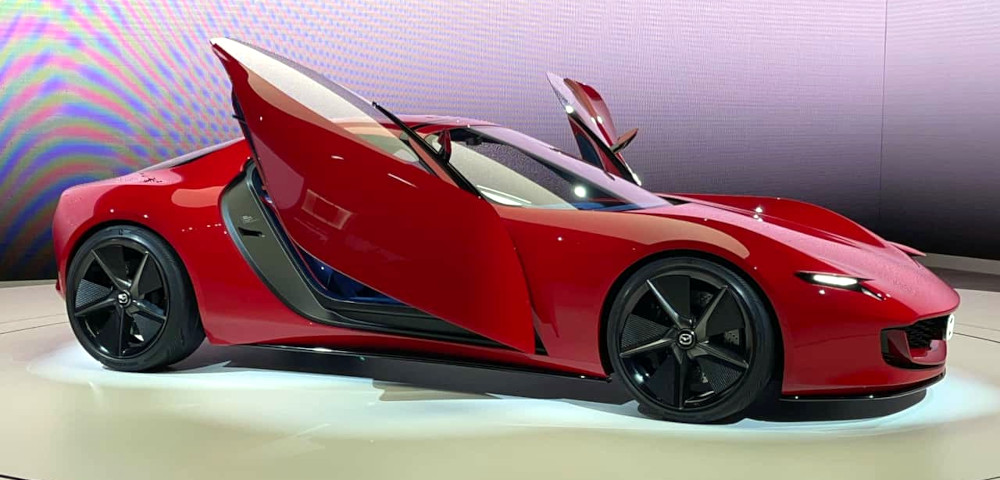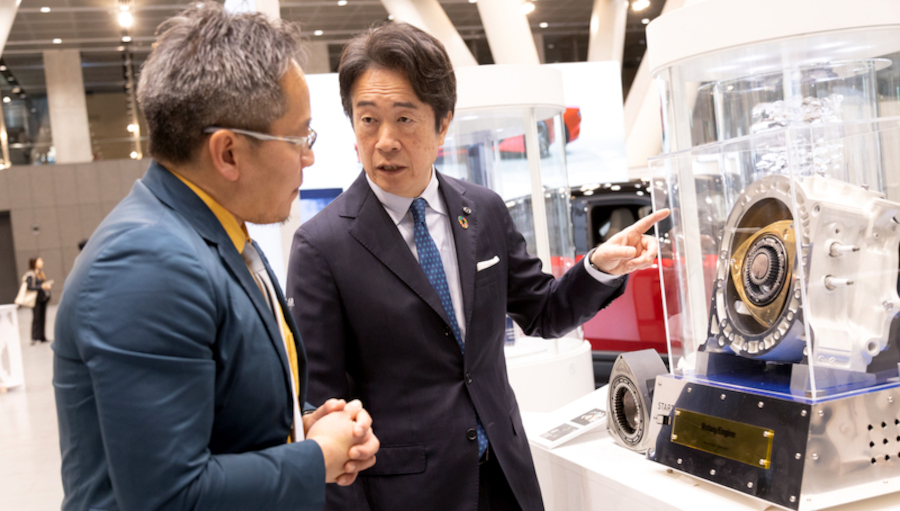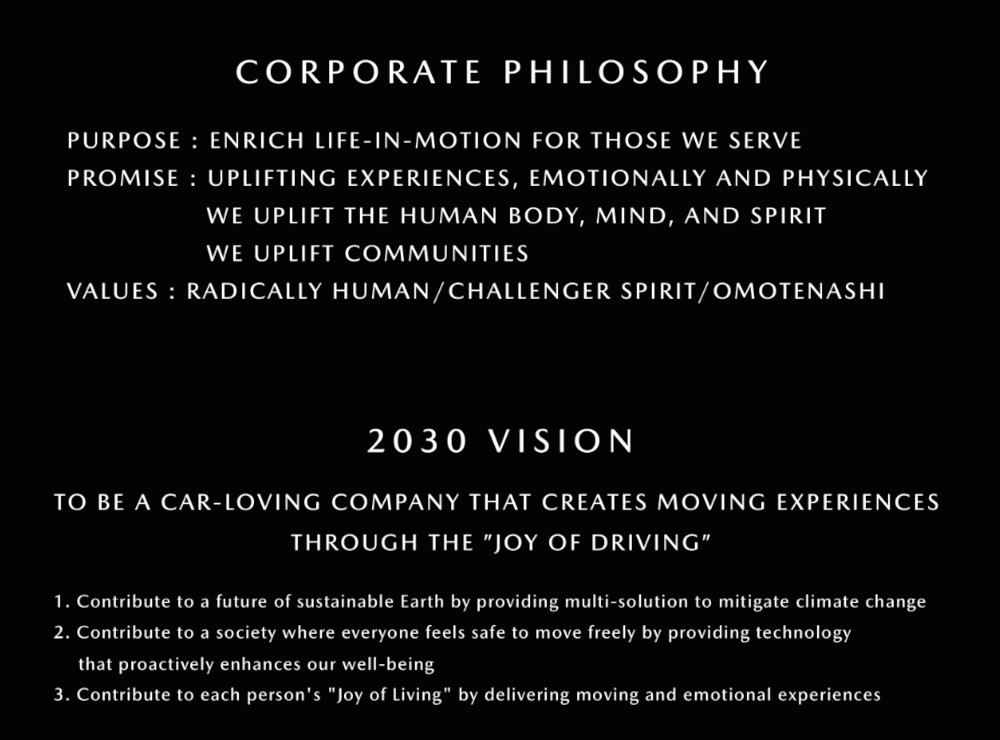How much can mobility contribute to human capability?
At SB’24 Tokyo-Marunouchi in February,
Masahiro Moro —
Representative Director, President and CEO of Hiroshima-based Mazda Motor
Corporation — spoke passionately about the joy of
driving, saying: "Mazda wants to continue offering the joy of driving, even in
the era of electrification."
In its 104-year history, Mazda has stood out with innovations such as the
rotary
engine. Now,
as the automotive industry works to transform toward carbon neutrality, how does
Mazda continue to embody its values and how will it strive to realize them?
In this interview with Moro, Sustainable Brands Tokyo Academic Producer
Shigeki Aoki learns more
about the 104-year-old global automotive manufacturer’s mission and strategies.
Aoki: In the plenary session, you spoke about how Mazda was deeply engaged in the post-war reconstruction of Hiroshima and how the way of life of the company's predecessors was to work diligently every day, nurtured by Mazda's 'challenger spirit' DNA. Can you tell us more about this?
Moro: During the war, Toyo
Kogyo, the
predecessor of Mazda, was located about 5 kilometers from the epicenter of the
atomic bombing. Thanks to small mountains like Hiji and Ogon shielding
the area from the blast, that HQ fortunately avoided major damage. Just four
months after the bombing, the company started producing three-wheeled trucks —
contributing to post-war reconstruction efforts.
Another significant aspect is our geographical distance from Tokyo. In national
policies aiming to send competitive automobiles out to the world, discussions
about consolidation naturally arise. However, the company had firmly rooted
itself in the region and continued to thrive; it requires unique technology for
this. The epitome of this is symbolized by the rotary engine — which we
successfully developed after 6.5 years, despite other automotive manufacturers
worldwide giving up on its practicality. We achieved full-scale production of
the rotary engine in 1967.
The spirit of the engineers who succeeded in developing the rotary engine has
been passed down across generations, leading to the development of the SKYACTIV
engine series — aiming to achieve
the world's best fuel efficiency for an internal-combustion engine.
Aoki: I heard that it was a difficult decision to temporarily discontinue production of the rotary engine to shift toward developing the SKYACTIV engine series.
Moro: Yes, this happened in 2012. However, even during that time, a small
group of engineers continued diligently with the technical development of the
rotary engine. They worked away quietly, deeply underground — tirelessly
continuing their research & development. That's the kind of dedication they have
— they were persistent. I think that aspect is one of the company's strengths
and makes us quite unique.
 The Mazda Iconic SP, a concept compact sports car unveiled at last year's
Japan Mobility Show | Image credit: Mazda Motor Corporation
The Mazda Iconic SP, a concept compact sports car unveiled at last year's
Japan Mobility Show | Image credit: Mazda Motor Corporation
Aoki: I watched last year's Japan Mobility Show via web video, and I saw a sudden increase in viewership when the Iconic SP appeared. How did you perceive the audience's reaction?
Moro: I was extremely delighted and encouraged, thanks to an overwhelming
response from around the world. The Iconic SP was proposed as one of the car
designs and packages that we want to create in the carbon-neutral era. However,
whether it would be accepted as a solution was something we wouldn't know until
we exhibited it. To accelerate toward a new form of scalable electric vehicle
models, gaining customer support is essential — and the enthusiastic cheers at
the show strengthened my resolve. It led to the reformation of the rotary engine
development group in February of this year.
Aoki: That was the balance between the mechanism of the rotary engine, which embodies your company's technical prowess, and appreciation for the beauty of sports cars, right? I belong to the Roadster generation, and I believe the essence of Mazda is evident in fan clubs like the Roadster Club of Japan and [Mazda sub-brand] Mazda Spirit Racing.
Moro: The [MX-5 Miata] Roadster, which has been on the market for around 34 years and has
sold approx. 1.2 million units, holds a Guinness World Record as the
most-produced lightweight sports car in the world. I think its success is
largely due to being nurtured by our customers. It's not a high-performance car
focused solely on engine power; rather, it's a sports car that provides
enjoyment as a total package. Our customers have found various ways to use and
enjoy it, expanding the joy of driving, and people from a lot of different
countries seem to agree with this.
Aoki: Since the Roadster, the market for lightweight sports cars expanded rapidly. In your opinion, what is the primary reason why the Roadster has continued its popularity?
Moro: Mazda creates dedicated platforms for sports cars, and each engineer
is committed to their work with a strong sense of dedication. For example, they
agonize over decisions like whether to shave off 1 millimeter from a
crossmember, knowing it will amount to a few grams of weight. While adding
safety features, being able to create a car weighing around 1 ton is a
culmination of the entire engineering team's dedication. I believe that
customers also support this kind of commitment. Even with the RX-7, we
pursued thorough weight-reduction strategies with initiatives such as "Operation
Zero" — which is part of the company's heritage. We may be seen as a troublesome
company because we don't easily accept the same methods as other companies.
That's why, even with the RX-7 — it only produces 250 horsepower; while other
companies are maxing out at the 280 limit according to the regulations. So, when
it comes to which is faster when driven, engineers strive to master the
technology. Therefore, we have focused on analyzing and working on how the
movement of a car affects human feelings and actions, specializing in the
vehicle's performance — this is the sensing technology of today's era. The
cooperative control computer adopted by our SKYACTIV engine has a fast
calculation speed, allowing for actions like revving the engine while applying
brakes. The central focus of our development is how the car needs to move to
provide a pleasant driving experience. This approach is then extended to other
vehicles.
 At the SB’24 Tokyo-Marunouchi exhibition booth, Masahiro Moro discusses the
Mazda rotary engine with Shigeki AOKI | Image credit: PATRONEFILM
At the SB’24 Tokyo-Marunouchi exhibition booth, Masahiro Moro discusses the
Mazda rotary engine with Shigeki AOKI | Image credit: PATRONEFILM
Aoki: With European, American and Chinese manufacturers taking the lead in electric vehicles — and with Toyota advancing a 'multi-pathway' strategy — what is Mazda’s timeline for shifting to electric vehicles?
Moro: As an automotive manufacturer, we see it as our societal mission to
respond to the demands of the times by complying with regulations for reducing
emissions. When the first CO2 regulations were introduced in Europe, we realized
that a long-term technological vision was necessary. We approached the issue
from the perspective of what would be most effective in reducing emissions
throughout the lifecycle of a vehicle. Our initial focus was on increasing the
efficiency of internal combustion engines, starting from around 2005.
Later, we embarked on the challenge of creating an engine with the highest
thermal efficiency globally — which we named the SKYACTIV engine.
In other words, we have been building up technologies within the scope of our
product line — combining internal-combustion engines with electrification
technology and shaping them into a range of solutions. This is part of our
"Building Block Concept." As we are not a company with vast resources, we have
been developing future-ready foundational technologies step by step over the
long term — with the idea of accumulating themes of technological development
that can be used in the future.
While also creating roadmaps for technologies using carbon-neutral fuels such as
hydrogen and biofuels, we have been approaching this in a slightly different way
than the "multi-pathway" strategy — by systematically tackling each aspect one
by one.
Aoki: I see. Until now, you have developed cars under the assumption that they will run on gasoline. However, while considering the feasibility of infrastructure development and raw materials procurement, you have been drawing up a diverse business portfolio. Finding the balance must have been challenging.
Moro: Yes, of course. When considering genuine CO2 reduction, the
composition of power sources and the extent to which customers participate the
most significant factors. We aim to provide technologies that align with our
customers' lifestyles and the progress of regional infrastructure. By
encouraging as many people as possible to try and use our technologies, we hope
to increase the number of cars in the market.
Our preference for internal-combustion engines and carbon-neutral liquid fuels
is primarily due to their high energy density. In contrast, electric power has a
significantly lower density — requiring large batteries for use in vehicles.
However, battery technology is undergoing constant innovation; and various
companies are developing technologies such as solar panels on car roofs or
systems to "charge from the road." As these technologies are implemented in
society, there is potential for solutions to evolve accordingly. Therefore, it's
not a matter of switching from electric cars today to hydrogen cars tomorrow. We
are currently in the dawn of these technologies, and they will require long-term
evolution and constant advancements. At Mazda, we are committed to three
factors: developing technologies that bring happiness to people; contributing to
society; and promoting widespread adoption.
Aoki: In this context, your partnership with Toyota in 2017 was aimed at collaborating on the development of autonomous driving and the widespread adoption of electric vehicles. Is this collaboration aimed at anticipating the spread of these technologies?
Moro: Our work with
Toyota is primarily
focused on jointly developing essential vehicle systems necessary for the
electrification era. The idea is that, as an industry, it's better to work
together to contribute to society as much as possible.
A clear example of co-creation among domestic automakers is seen in the Super
Endurance Race
— where Toyota, Subaru and Mazda use the same carbon-neutral fuel and
exchange race-result data. Although races are typically conducted with some
secrecy, each engine type produces different results — even with the same fuel.
By investigating this with all three companies, we can uncover things that might
be missed otherwise. I believe that this will lead to the faster and
more-confident implementation of carbon-neutral fuels in society.
Aoki: Mazda has garnered accolades such as "World Car of the Year" and "World Car Design of the Year." How has Mazda gained a unique identity and strengthened its core aspects through the challenges of global competition, starting as a domestic company in Japan?
Moro: We have learned a lot. In the past, there was a desire to become the
third brand in Japan — and we were starting to create too many different types
of cars and losing our individuality. But when Ford came in (as a capital
alliance that was formed in 1979; subsequently dissolved), we decided to try it
again. We realized that we specialize in sporty cars that are comfortable to
drive. In the 2000s, this trend led to the creation of the Mazda brand's
"Zoom-Zoom"
[slogan] — which expresses the "excitement of the movement that we felt as
children.''
Although this word is an emotional expression, the core essence is still the
“joy of driving.” Brands are just like people, and what they are born with does
not change much. However, if you go out into the world, you become refined in
various aspects and your brand will grow. The technology, quality and appearance
of cars will change.

Aoki: Mazda’s "2030 Vision" set out a strong message for 2030; and in your plenary speech, you talked about the company purpose to "enrich life-in-motion for those we serve." Can you tell us more about that?
Moro: As the automobile industry undergoes a major transformation into a
mobility industry, we need to make sure that our employees and other
stakeholders understand what Mazda is doing over time. By 2030, we aim to be a
car-loving company that creates moving experiences through the "joy of driving"
— but the word “automobile” does not appear anywhere in this purpose.
Although it took about a year to decide on this purpose, holding many workshops
was very exciting. The people of the Showa generation (i.e., Japan’s Showa
era [1926–1989]) like us wouldn't
know what a company would do if it didn't mention the word "automobile," but the
younger generation in their 30s clearly have a different mindset. However, to
engage people in their 50s and 60s, we included the word "car" in our vision.
The phrase "enrich life-in-motion for those we serve" refers to postwar
Hiroshima, where people worked hard to rebuild each day — making each day a good
day, exchanging smiles and expanding the circle of people in the community. It
also overlaps with the 100-year life of Hiroshima's predecessors, who have
expanded and progressed to become the peaceful city that it is today. I think
it's a great fit for the company.
Get the latest insights, trends, and innovations to help position yourself at the forefront of sustainable business leadership—delivered straight to your inbox.
Sustainable Brands Japan
Published Jun 13, 2024 8am EDT / 5am PDT / 1pm BST / 2pm CEST